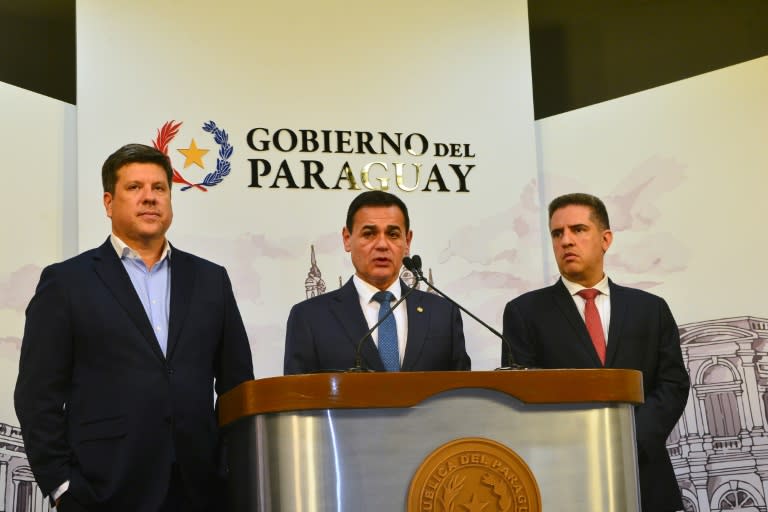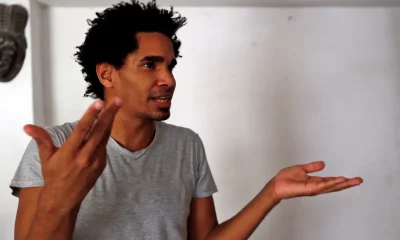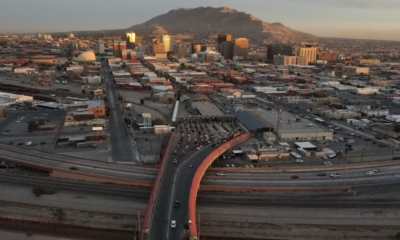International
‘You lose hope’: Cuban exodus to US largest in island’s history

| By AFP | Gerard Martinez with Rigoberto Diaz in Havana |
Exhausted by “surviving instead of living” in Cuba, David Gonzalez set his sights on a new life in the United States.
In early 2022, he joined thousands of Cubans whose migration has amounted to the largest exodus in the Caribbean nation’s history.
Gonzalez, a 34-year-old barber, said he could no longer bear the hardships of a country going through its worst economic crisis since the 1990s, or the communist regime he had never embraced.
In Cuba, “you lose hope,” he told AFP from Miami, Florida, which he reached after a weeks-long odyssey across multiple countries.
That hopelessness, shared by many young people in Cuba, has pushed emigration to the United States to the highest levels on record.
In the year from December 2021 to 2022, border authorities recorded more than 227,000 instances of Cubans illegally entering US territory.
That figure exceeds those of two previous mass departures: the Mariel boatlift, when 125,000 Cubans left for the United States in 1980, and the 1994 departure of 34,000 people to US shores within a month, said Jorge Duany, a Cuba expert at Florida International University.
‘My biggest fear’
Gonzalez’s journey started with a flight to Nicaragua.
The government of the Central American country, an ally of the Havana regime, removed visa requirements for Cubans in November 2021, making Managua the first stop on the road to the United States for most migrants from the island.
The journey cost Gonzalez some $7,000: $3,500 for the airfare and another $3,500 for smugglers to take him overland from Nicaragua to the United States — a huge sum for the average Cuban salary of 3,768 pesos a month, about $157.
Gonzalez scrounged half the money by selling his motorcycle and other belongings. A friend sent him the rest from Miami.
From his 30-day trip through Central America and Mexico, he remembers above all the long rides with dozens of people crammed on a bus or in the back of a truck.
But it wasn’t the prospect of thirst, lack of air, unbearable heat during the day and biting cold at night that scared him the most on the journey.
“My biggest fear was that I would be deported to Cuba,” he said.
Danger at sea
Others choose a different route to the United States no less rife with danger, risking their lives to travel the 90 miles (145 kilometers) of water that separates Cuba and Florida often in makeshift vessels.
On Christmas Day, 15 people were picked up in the Florida Keys, where dozens of Cubans arrive every week.
Mariana de la Caridad Fernandez made the journey in November.
The 20-year-old and her sister Yaneris, 31, had been sentenced in Cuba to four years of house arrest and seven years in prison respectively for participating in demonstrations that shook the country in July 2021.
Having been on the run in Cuba for a month, they decided to make for Miami, where their mother lives.
The sea was calm during the 16-hour crossing with their dog, Toby, and 40 others packed into the boat.
“We panicked a bit when we arrived in the early hours of the morning and had to get off the boat and swim to get to land,” Fernandez said.
A border patrol immediately detained the sisters, but released them on parole, giving them temporary leave to stay in the country.
Aiming to apply for political asylum, they hope to legalize their status under the Cuban Adjustment Act, which allows Cubans to apply for residency a year and a day from when they entered the United States.
‘See a future’
Others haven’t been so lucky.
Many who are picked up in boats by the US Coast Guard are quickly sent back to Cuba, unless they prove their lives are in danger.
Since October 1, the Coast Guard has detained over 3,700 Cubans, more than half the number taken into custody between October 2021 and the same month in 2022.
Then there are the untold numbers of Cubans who die at sea.
In April, a boat carrying 14 men capsized three days after departing Cuba. Only five managed to swim back to the island.
The nephew of Miriela, a Cuban woman who preferred not to give her last name, was one of those who disappeared in the wreck.
“It pains us not knowing what happened to him,” she said.
For Gonzalez, the risks he took to reach Miami were worth it.
Now also on parole, he hopes to avoid deportation until he can try for residency via the Cuban Adjustment Act.
“In eight months I already have what I didn’t have in Cuba,” he said.
“It’s not just the material comforts, but that you can see a future.”
International
Paraguay summons Brazilian ambassador over Itaipú espionage scandal

Paraguay summoned the Brazilian ambassador in Asunción on Tuesday to demand “explanations” and called its own representative in Brasília for consultations following Brazil’s acknowledgment of an espionage operation. The Brazilian government, led by President Luiz Inácio Lula da Silva, attributed the operation to the previous administration.
The surveillance effort aimed to uncover Paraguay’s position in now-suspended negotiations with Brazil regarding the pricing of electricity from the binational Itaipú hydroelectric plant, according to reports in the Brazilian press.
The Brazilian government “categorically denied any involvement in the intelligence operation,” stating in a Foreign Ministry communiqué on Monday that the espionage was carried out under former President Jair Bolsonaro’s administration (2019-2023).
“The operation was authorized by the previous government in June 2022 and was annulled by the interim director of the (state intelligence agency) ABIN on March 27, 2023, as soon as the current administration became aware of it,” Brazil’s government asserted.
Paraguay’s Foreign Minister Rubén Ramírez announced that Brazilian Ambassador José Antonio Marcondes de Carvalho was summoned “to provide detailed explanations” regarding the operation. Additionally, Paraguay recalled its diplomatic representative in Brasília “to report on aspects related to the intelligence activity conducted by Brazil regarding Paraguay’s government affairs.”
International
Elon Musk to step down as government advisor, per Trump insiders

President Donald Trump has informed his inner circle that Elon Musk will be stepping down from his role as a government advisor, according to a report by Politico today.
Citing three individuals close to Trump, Politico states that the president is pleased with Musk’s leadership at the Department of Government Efficiency (DOGE), where he has implemented significant budget cuts. However, both have agreed that it is time for Musk to return to his businesses and support Trump from a different position outside the government.
A senior administration official told Politico that Musk will likely maintain an informal advisory role and continue to be an occasional visitor to the White House. Another source warned that anyone thinking Musk will completely disappear from Trump’s circle is “deluding themselves.”
According to the sources, this transition is expected to coincide with the end of Musk’s tenure as a “special government employee,” a temporary status that exempts him from certain ethics and conflict-of-interest regulations. This 130-day period is set to expire in late May or early June.
International
Milei vows to make Argentina so strong that Falkland Islanders “choose” to join

Argentine President Javier Milei reaffirmed his country’s claim over the Falkland Islands (known as the Islas Malvinas in Argentina) and praised the role of the nation’s armed forces during a ceremony marking the “Veterans and Fallen Soldiers of the Malvinas War Day,” commemorating 43 years since the 1982 conflict with the United Kingdom.
Argentina continues to assert sovereignty over the islands, arguing that Britain unlawfully seized them in 1833.
“If sovereignty over the Malvinas is the issue, we have always made it clear that the most important vote is the one cast with one’s feet. We hope that one day, the Malvinas residents will choose to vote with their feet and join us,” Milei stated.
“That is why we aim to become a global power—so much so that they would prefer to be Argentine, making deterrence or persuasion unnecessary. This is why we have embarked on a path of liberation, working to make Argentina the freest country in the world and once again the nation with the highest GDP per capita on the planet,” he added.
-

 Central America4 days ago
Central America4 days agoU.S. Homeland Security Secretary urges Mexico to strengthen Guatemala border
-

 Central America4 days ago
Central America4 days agoPanama grants Martinelli 72-hour extension to travel to Nicaragua
-

 International2 days ago
International2 days agoParaguay summons Brazilian ambassador over Itaipú espionage scandal
-

 Central America5 days ago
Central America5 days agoPanama police clarifies that Interpol alert for Martinelli is still pending
-

 International4 days ago
International4 days agoTrump urges Putin to reach peace deal
-

 International5 days ago
International5 days agoDeportation flight lands in Venezuela; government denies criminal gang links
-

 Sports2 days ago
Sports2 days agoFilipe Luis debuts as coach in Copa Libertadores with Flamengo
-

 Central America2 days ago
Central America2 days agoGuatemalan police officer killed in mob riots over baby kidnapping
-

 International2 days ago
International2 days agoElon Musk to step down as government advisor, per Trump insiders
-

 Sports2 days ago
Sports2 days agoVenezuela investigates 18 baseball players seeking asylum in Spain
-

 International2 days ago
International2 days agoMilei vows to make Argentina so strong that Falkland Islanders “choose” to join
-

 International2 days ago
International2 days agoÓscar Arias: Trump’s trade policies are a step backward
-

 International2 days ago
International2 days agoICE agent’s arrest of suspect sparks controversy in Boston































































































